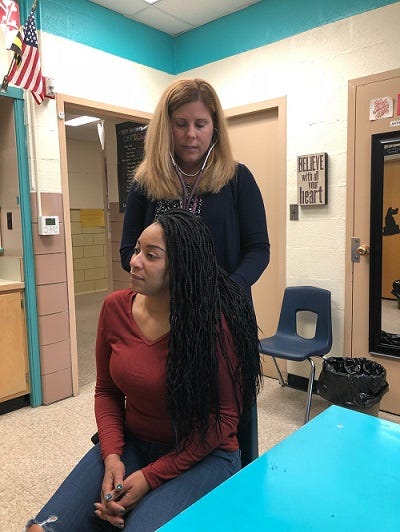Coping Skills for Educators from a Maryland School Nurse
Recognizing and dealing with educator stress

Kimberly Finley is a registered nurse at Baltimore County’s Hawthorne Elementary School. Like many school nurses, she delivers care not only to students in the school, but to the adults as well. We talked with Kimberly recently about recognizing and coping with the symptoms of educator stress.
Where does educator stress come from? What does it look like?
For educators, expectations are being raised each year while support is often reduced as result of funding cuts. Constantly changing job expectations alone are a huge stressor. But there’s more.
Educators understand that they have a responsibility to provide students with a safe, stable, and healthy learning environment but they have no control over a student’s home life. My co-workers are deeply affected by our students’ life experiences including, traumas, hunger, incarceration of a family member, unsafe neighborhoods, economic status, and other adverse childhood experiences (ACEs). They don’t, however, often connect their own stress and its symptoms — like headache, stomachache, chest pain, and muscular pain — with that of their students, classroom behavior and the inability to control it, a lack of student services, parent compliance, and other student and school issues.
Educators can help students move away from their trauma towards growth, resilience, success, and happiness.mseanewsfeed.com
My student nurse said recently that she was surprised I spent so much time on the health problems of our staff. It was a fair and honest observation. I believe most schools understand that healthy students learn better, but they must also understand that a healthy teacher instructs better and can make a greater impact on a student’s education and life.
Last year, I had a few hundred visits from staff into my health suite. I often bring in breakfast sandwiches, special coffees or teas, coloring books, and, most importantly, candy that I keep in a can marked TREATS. Everyone knows that I don’t count how many pieces someone takes, but I do use the can as a gauge of how difficult the day or week had been.
How do you address the challenge of assisting staff with health issues?
I’ve created a safe, trusted, private, confidential, and non-judgmental space so my colleagues feel comfortable and supported in sharing a physical or mental health concern. What is shared stays with me.
This school year, I opened a discussion with my staff about stress and stressors. Stress can come from good (a new job or house, the birth of a child) and bad (the loss of a family member or job, a divorce) events in our lives.
What are your suggestions to help educators deal with the stress of their jobs?
A teacher’s environment and administration has the ability to make them or break them. I feel fortunate to work with my co-workers towards building a healthy and resilient school community.
To manage stress effectively, you must take a holistic approach and should include physical, mental, and spiritual assessments. The most powerful thing a person can do is to acknowledge that stress exists.
Compassion fatigue is real, rampant, and often unacknowledged.mseanewsfeed.com
I’d like to share some great advice from a college nursing professor: most of us do not have the time to spend four hours on ourselves (let alone an hour), but there are many things you can do in five minutes.
5 ways Nurse Kim helps co-workers manage stress on the job:
1. If someone is having an emotional moment in my office, I first allow them to just talk while I listen quietly.
2. I offer my presence or, if they prefer privacy, another room off my main office.
3. I have a long mirror in my office. If an educator’s stress is related to unrealistic expectations or being overly critical of themselves, I place my hand on their shoulder and ask them to say their name and three things they like about themselves.
For instance, “My name is Nurse Kim. I am a caring, kind, and compassionate nurse who has the pleasure of serving my staff, students, and my school community with healing hands, knowledge, and words. I will continue to learn to the best I can be and allow myself room to grow in my profession.”
4. If a co-worker has trouble with the suggestion above, I say 10 things that I like about them. I emphasize we can thank others for kind words, but it’s the words we tell ourselves that are the loudest.
5. I recommend aromatherapy (lavender for calmness, eucalyptus for reducing stress and helping with respiratory issues), music, humor, yoga, coloring, deep breathing, worry stones, stretching, journaling, massage, meditation, and repeating a phrase from a book or poem that they love or a mantra that they create for themselves.

